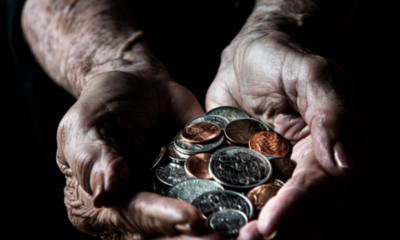Life
Why Do We Have An Unconscious Bias and How Can We Manage It?

When I hear someone using my name once in a while throughout the conversation we are having, I cannot stop myself thinking “this person must have read Dale Carnegie’s books or must have been influenced by someone who read them…” Have you just recalled a similar moment and it felt nice?
As Dale Carnegie famously said, “Remember that a person’s name is, to that person, the sweetest and the most important sound in any language”. Why did Dale Carnegie highlight the importance of an individual’s name to that person in his “How to Win Friends and Influence People” book published in 1936?
Each and every one of us wants to feel special and unique. I guess he recommends using the person’s name in the conversation because that is one of the easiest ways to grab that person’s attention so that we can enhance the chances of getting our point across. However, I am more interested in this from the other side; hearing our names directly addresses our individuality, our need or desire to feel special and unique.
Let’s park this one for now and we will come back.
Categorization is essential to our survival
There is countless scientific research telling us about how our brains recognize similarities and put things into categories, which has been crucial to our survival in evolution and still helps us with a lot of things from learning new things to coping with the continuous influx of massive amounts of information through our senses.
The continuous influx of information is mostly handled by our subconscious mind rather than conscious. It is estimated that our brains receive about 11 million bits of information every second through our senses, of which only 40-50 bits can be processed by our conscious mind. We process more information than we are aware of. The magic here is the subconscious mind.
An example is when you are at a very loud party where you hear a lot of words flying around without you recognizing each one of them, then suddenly, you immediately catch it when you hear your name. Your subconscious had been processing all of those words, without your awareness, but informed your conscious mind when your name was out there because it was relevant to you.
In order to most effectively process this much information and inform the conscious mind with only the relevant ones, our subconscious employs categorization as one of its strategies.
When our ancestors encountered some deadly predators in the African savanna, their subconscious prompted their conscious mind to immediately fight or flight by categorizing the information gathered through their senses into “predator / life threat / take action”. Most probably we are not descendants of the ones that were frozen rather than fighting or flighting!
Although it is a completely different situation, the same strategy applied in remembering lists. Let’s look at the below two lists.
- lion, eagle, shark, leopard, hawk, whale, panther, falcon and dolphin
- lion, leopard, panther, eagle, hawk, falcon, shark, whale and dolphin
The second list is easy to remember because it is reordered into relevant groups even though the content of the both lists are identical.
Subconsciousness is the magic and categorization is one of its key strategies. It is essential to our survival, learning new skills and processing information as well as bringing back the information we had processed and stored.
This amazing skill has its drawbacks
As a result of our brains’ categorization strategy, we also categorize people, especially if we don’t know them as well as our closest ones.
Imagine I am sitting at the table next to yours while you are having your favorite coffee and working on your computer or reading your novel at your neighborhood coffee shop. I stand up, very calmly grab your bag, and start walking away. Your reaction might be quite different depending on my outfit. It could be much more vocal and harsh if I have a dirty T-Shirt and a pair of torn jeans on. However, if I have some navy colored, 3-piece suit and well-pressed white button up shirt on, you might even say something like “Excuse me, you might have picked up my bag by mistake”. (There is an experiment done by social psychologists which reported similar results)
Similarly, I would not be surprised to hear that my co-worker’s spouse is very skilled and knowledgeable in English grammar and literature because he is an English teacher. However, I would not expect it from my co-worker herself because she is an outstanding chemical engineer.
This is defined as unconscious bias or stereotyping, as a result of our subconscious brain’s categorization strategy. The outfit I have at the coffee shop impacts your response to my action, because it puts me into a different category in your mind depending on my outfit. My co-worker’s and her spouse’s backgrounds make me put them into different categories, which might mislead me sometimes.
Just like we categorize things, it is very natural that we categorize people.
The key question here for me is; how do we truly treat people as individuals so that they feel unique, just like as they would want, while we know that our brains categorize people?
We can overcome unconscious bias
Leonard Mlodinow, in his enlightening book “Subliminal”, suggests that “if we are aware of our bias and motivated to overcome it, we can.” That doesn’t mean that we need to fight our brain’s categorization strategy. We just need to employ our conscious mind more when we are working or dealing with individuals.
Our unconscious bias might tell us scientists are bunch of technical nerds who cannot understand abstract concepts that marketers are talking about or it might say that marketers are some daydreamers who need to be grounded by scientists to the real world all the time. I am an engineer and I love thinking in abstract terms and I worked with quite a lot of marketers who thought primarily in factual and concrete terms.
Spending some effort to learn more about individuals will help overcome unconscious bias. Gathering more information and qualities about them will make it easier for us to treat them as individuals rather than a member of the category we put them in our minds.
The moral of the story here is to recognize the fact that our brains do categorize, and it is essential; but also, to recognize that every individual wants to feel unique. When we appreciate these two and keep reminding them to ourselves, we are one step closer to figuring out our own way to overcome unconscious bias and treat people more like individuals.
What was the most interesting part of this article for you? Share your thoughts below!
Did You Know
How Skilled Migrants Are Building Successful Careers After Moving Countries
Behind every successful skilled migrant career is a mix of resilience, strategy, and navigating systems built for locals.

Moving to a new country for work is exciting, but it can also be unnerving. Skilled migrants leave behind familiar systems, networks, and support to pursue better job opportunities and a better future for their families. (more…)
Life
10 Research-Backed Steps to Create Real Change This New Year
This New Year could finally be the one where you break old patterns and create real, lasting change.

Every New Year, we make plans and set goals, but often repeat old patterns. (more…)
Life
9 Harsh Truths Every Young Man Must Face to Succeed in the Modern World
Before chasing success, every young man needs to face these 9 brutal realities shaping masculinity in the modern world.

Many young men today quietly battle depression, loneliness, and a sense of confusion about who they’re meant to be.
Some blame the lack of deep friendships or romantic relationships. Others feel lost in a digital world that often labels traditional masculinity as “toxic.”
But the truth is this: becoming a man in the modern age takes more than just surviving. It takes resilience, direction, and a willingness to grow even when no one’s watching.
Success doesn’t arrive by accident or luck. It’s built on discipline, sacrifice, and consistency.
Here are 9 harsh truths every young man should know if he wants to thrive, not just survive, in the digital age.
1. Never Use Your Illness as an Excuse
As Dr. Jordan B. Peterson often says, successful people don’t complain; they act.
Your illness, hardship, or struggle shouldn’t define your limits; it should define your motivation. Rest when you must, but always get back up and keep building your dreams. Motivation doesn’t appear magically. It comes after you take action.
Here are five key lessons I’ve learned from Dr. Peterson:
-
Learn to write clearly; clarity of thought makes you dangerous.
-
Read quality literature in your free time.
-
Nurture a strong relationship with your family.
-
Share your ideas publicly; your voice matters.
-
Become a “monster”, powerful, but disciplined enough to control it.
The best leaders and thinkers are grounded. They welcome criticism, adapt quickly, and keep moving forward no matter what.
2. You Can’t Please Everyone And That’s Okay
You don’t need a crowd of people to feel fulfilled. You need a few friends who genuinely accept you for who you are.
If your circle doesn’t bring out your best, it’s okay to walk away. Solitude can be a powerful teacher. It gives you space to understand what you truly want from life. Remember, successful men aren’t people-pleasers; they’re purpose-driven.
3. You Can Control the Process, Not the Outcome
Especially in creative work, writing, business, or content creation, you control effort, not results.
You might publish two articles a day, but you can’t dictate which one will go viral. Focus on mastery, not metrics. Many great writers toiled for years in obscurity before anyone noticed them. Rejection, criticism, and indifference are all part of the path.
The best creators focus on storytelling, not applause.
4. Rejection Is Never Personal
Rejection doesn’t mean you’re unworthy. It simply means your offer, idea, or timing didn’t align.
Every successful person has faced rejection repeatedly. What separates them is persistence and perspective. They see rejection as feedback, not failure. The faster you learn that truth, the faster you’ll grow.
5. Women Value Comfort and Security
Understanding women requires maturity and empathy.
Through books, lectures, and personal growth, I’ve learned that most women desire a man who is grounded, intelligent, confident, emotionally stable, and consistent. Some want humor, others intellect, but nearly all want to feel safe and supported.
Instead of chasing attention, work on self-improvement. Build competence and confidence, and the rest will follow naturally.
6. There’s No Such Thing as Failure, Only Lessons
A powerful lesson from Neuro-Linguistic Programming: failure only exists when you stop trying.
Every mistake brings data. Every setback builds wisdom. The most successful men aren’t fearless. They’ve simply learned to act despite fear.
Be proud of your scars. They’re proof you were brave enough to try.
7. Public Speaking Is an Art Form
Public speaking is one of the most valuable and underrated skills a man can master.
It’s not about perfection; it’s about connection. The best speakers tell stories, inspire confidence, and make people feel seen. They research deeply, speak honestly, and practice relentlessly.
If you can speak well, you can lead, sell, teach, and inspire. Start small, practice at work, in class, or even in front of a mirror, and watch your confidence skyrocket.
8. Teaching Is Leadership in Disguise
Great teachers are not just knowledgeable. They’re brave, compassionate, and disciplined.
Teaching forces you to articulate what you know, and in doing so, you master it at a deeper level. Whether you’re mentoring a peer, leading a team, or sharing insights online, teaching refines your purpose.
Lifelong learners become lifelong leaders.
9. Study Human Nature to Achieve Your Dreams
One of the toughest lessons to accept: most people are self-interested.
That’s not cynicism, it’s human nature. Understanding this helps you navigate relationships, business, and communication more effectively.
Everyone has a darker side, but successful people learn to channel theirs productively into discipline, creativity, and drive.
Psychology isn’t just theory; it’s a toolkit. Learn how people think, act, and decide, and you’ll know how to lead them, influence them, and even understand yourself better.
Final Thoughts
The digital age offers endless opportunities, but only to those who are willing to take responsibility, confront discomfort, and keep improving.
Becoming a man today means embracing the hard truths most avoid.
Because at the end of the day, success isn’t about luck. It’s about who you become when life tests you the most.
Change Your Mindset
The Four Types of Happiness: Which One Are You Living In?
Most people chase success only to find emptiness, this model reveals why true happiness lies somewhere else.

In a world driven by rapid technological growth and constant competition, many people unknowingly trade joy for achievement. (more…)
-

 Business4 weeks ago
Business4 weeks agoWhy Your E-Commerce Fulfilment Is Probably Broken (And How to Fix It)
-

 Shift Your Mindset3 weeks ago
Shift Your Mindset3 weeks ago11 E’s That Define Every Great Leader And Why Most People Miss Them
-

 Did You Know3 weeks ago
Did You Know3 weeks agoThe Success Patterns You Inherited (And Didn’t Notice)
-

 Business3 weeks ago
Business3 weeks agoThe Hidden Money Pit in Your Operations (and How to Use It)
-

 Entrepreneurs2 weeks ago
Entrepreneurs2 weeks agoThe Essential Skills Every Entrepreneur Needs In 2026
-

 Change Your Mindset2 weeks ago
Change Your Mindset2 weeks agoHow to Turn Your Mind Into Your Greatest Asset (Instead of Your Enemy)
-

 Change Your Mindset1 week ago
Change Your Mindset1 week agoThe Silent Skill That Makes People Respect You Instantly
-

 Life6 days ago
Life6 days ago10 Research-Backed Steps to Create Real Change This New Year


























